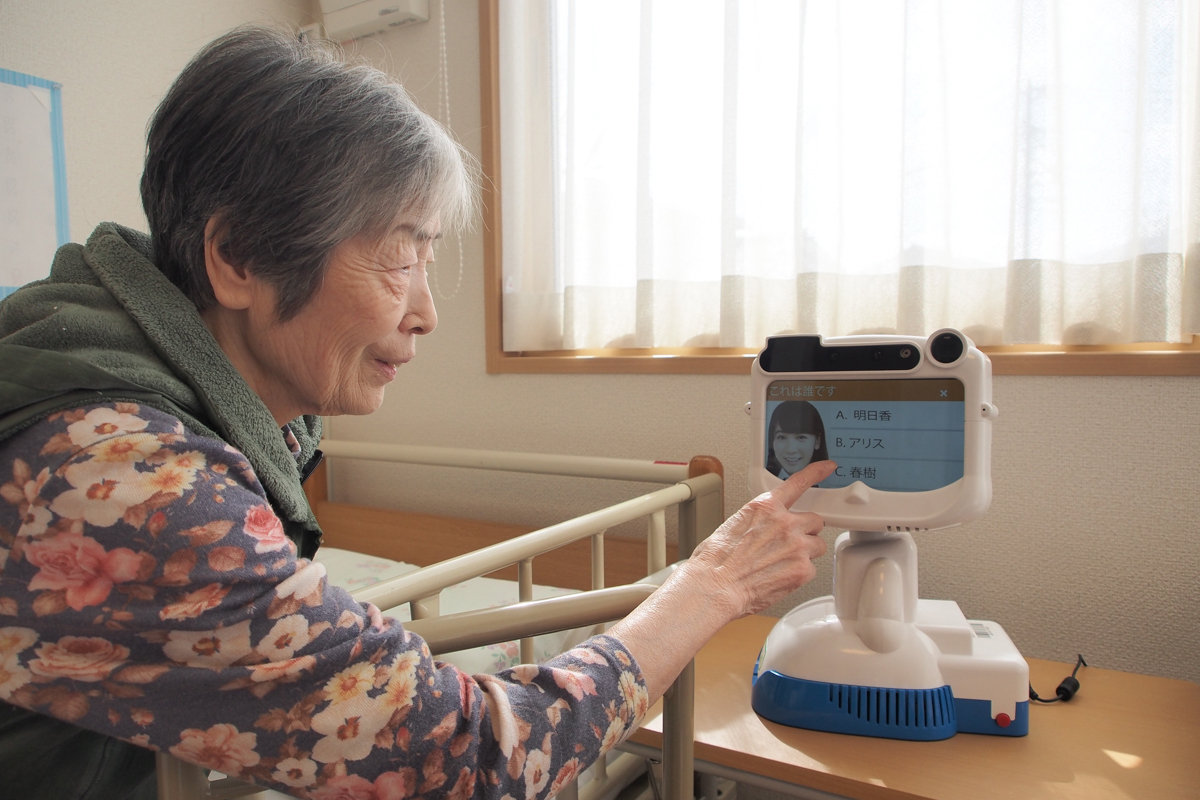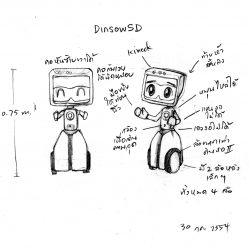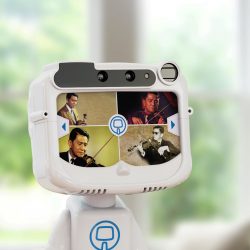With the arrival of this robot helper ‘Dinsor Mini’, our worries about growing elderly are now relieved
It would be pretty strange to say that Doraemon is Thai. And while we all know that such statement is not true, there is something relatively close happening that can be explained with a different robot name. We’re talking about not Japanese but Thai robots currently working in Japan, the country known as the origin of robots and progressive technology, the unlikely place for a no-name robot from Thailand to find its place. So what exactly is this Thai robot doing in Japan and how did it get there in the first place?
When it comes to robots, what most people want to know is what they are capable of, letting their imaginations go in regards to all the cool stuff it could do. But before we get there, let’s learn about its designated responsibilities. Each robot is created with a mission or one might call it a design framework. Take for example, the multi-functional ability of a robot that may contribute to its incredibly high cost, but what you have is a robot that can do a lot of things but isn’t really good at anything. Designing a robot is, therefore, about designating a clear mission. It can be a small one that doesn’t require any highly advanced technology but can effectively achieve the set mission, for instance, the robots working in industrial plants or waiting tables at restaurants. There is also a kind of robot developed specifically with the ability to take care of the elderly, and it has been met with high demand in several countries across the world.
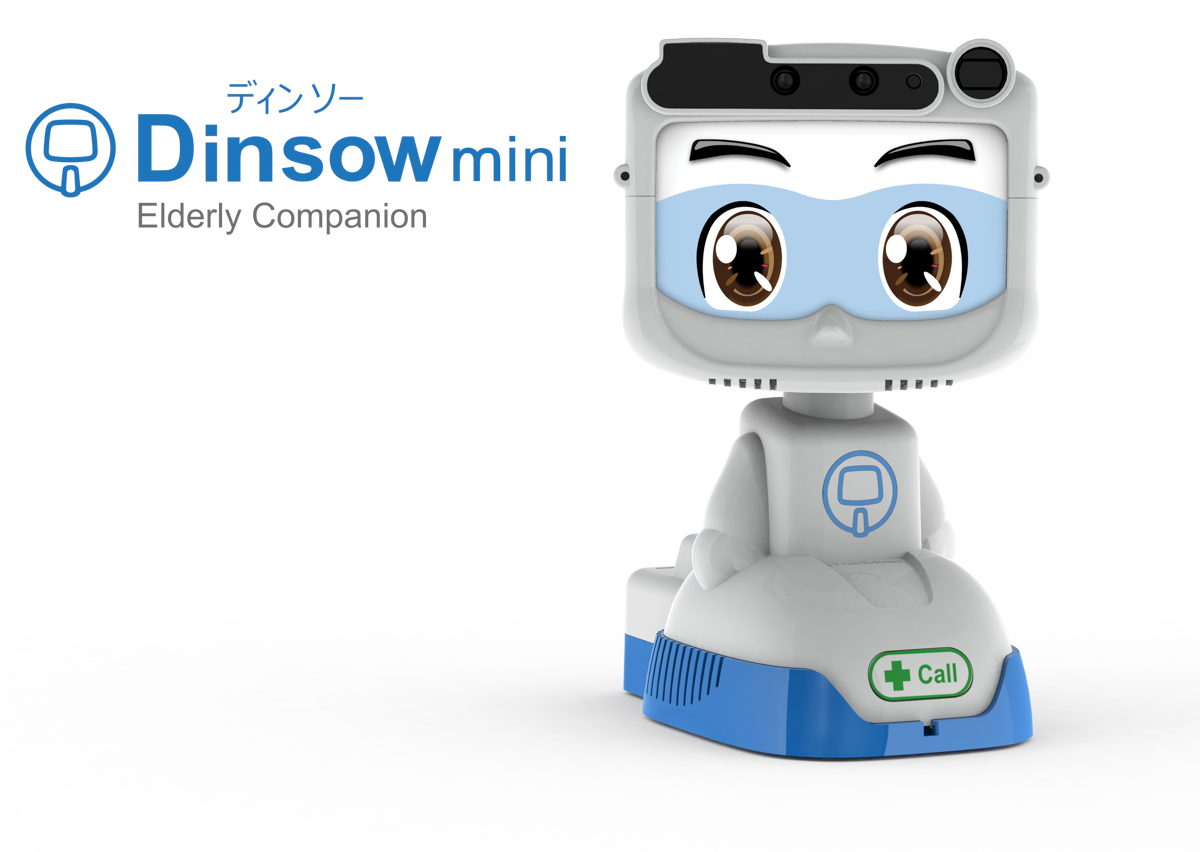
The United Nations estimates that the time between 2001 and 2100 is the century of the aging society, meaning that more than 10% of the world’s population will be above 60 years of age with Japan being home to a particularly high number of over 30 million senior citizens out of the country’s total population (127 million). Such transition has ignited the design trend that puts high consideration on ‘universality’ with the senior demographic being the main focus. We have seen countless sensory technologies and wireless connectivity of modern-day devices that allow for the care robot to function more effectively as the technology becomes highly useful for modernday elderly care. It is a price people are willing to pay, especially when taking care of the elderly can be a matter of life or death.
Chalermphol Punnotok talked with art4d about Dinsow mini, the first Thai robot he developed from a marketing aspect that looked for a product like an elderly care robot that could potentially become a household item for families in the world’s biggest aging society such as Japan. The targeted users of Dinsow mini are seniors whose health conditions require them to rest in bed or those who have to stay at home alone while their children go out to work. Dinsow is a companion who keeps an eye on the elderly while offering family members access to what’s going on at home or alerts them if there’s any out of the ordinary incident happening with the senior. Dinsow will notify the family when the elderly under its care wakes up or goes to the bathroom at night. It will remind the elderly to take medicine, answers the phone for them, plays their favorite music or plays brain training games like guessing the names of their children and grandchildren to keep their brains and memories active. Dinsow mini isn’t the product of incredibly advanced technology, but it brings together what it needs to achieve the set out mission. The robot is designed specifically for its targeted users — the seniors who aren’t exactly looking for the latest technological development like the younger generation, but something that is easy to use, practical and doesn’t require an update every six months or so. Dinsow is now available in Japan with a starting price of 300,000 yen and it has been used by several nursing homes. It’s a courageous attempt by a Thai developer that deserves all the support it needs. Punnotok told us that he hasn’t found any competitors in the market, which we find to be quite surprising considering how it could become a much-needed solution for the imminent aging society.
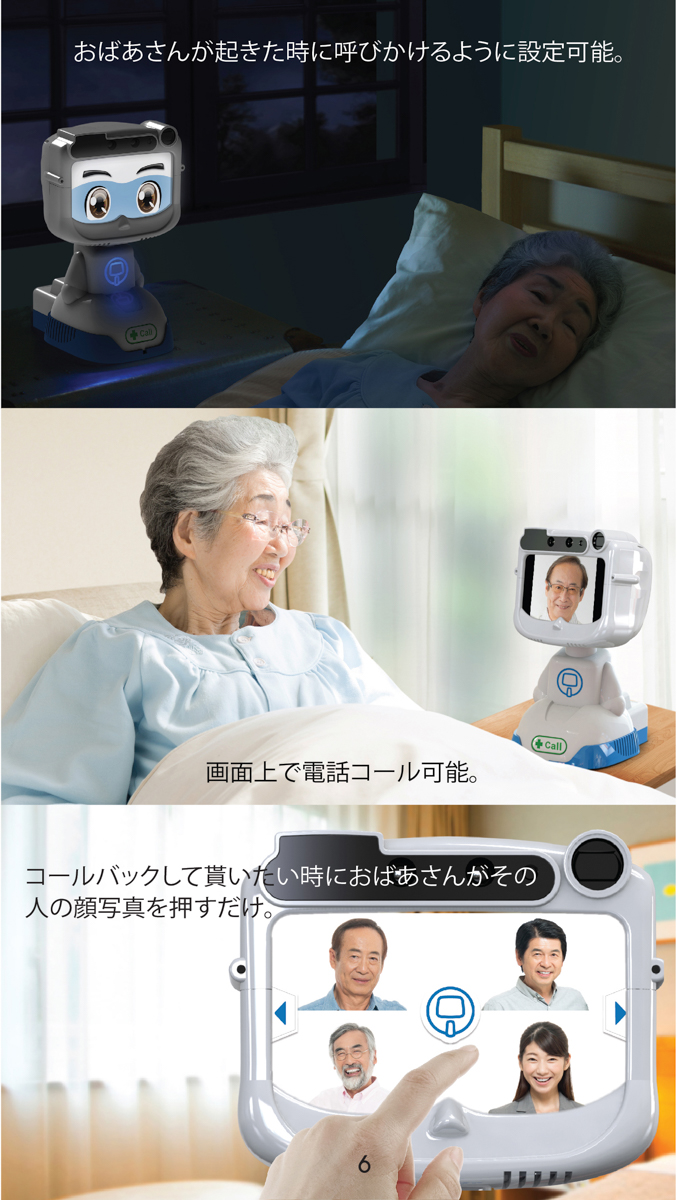
In reality, the nature of design products plays with the balance between what we ‘need’ and what we ‘want.’ But this is the time when we are able to say that there are not that many things that are essential to our lives at the same level as the four factors of living, and it seems that all has been developed to almost reach the end of the road. The things humans ‘want’ may actually refer to the market’s demand for newer versions; the latest update from the new season. Why do we have to buy a new chair when we are able to buy a comfortable and affordable one that offers exactly the same functionality? It’s because humans always demand to possess newer things and the market has to continue its course. New chairs have been designed and released into the ocean of chairs that are all good and beautiful. Sometimes, it’s just a simple hypothesis like this that we overlook. So is it possible for designers to focus more on what humans ‘need’ rather than what humans ‘want,’ connecting the dots that are really important and ultimately finding and prioritizing the solutions. We may be able to find different ways out to the many problems we’re facing and solutions that can benefit a wider group of people. A step out of a popular trend can lead to something simple yet surprisingly unprecedented.
ถ้าจะบอกว่าโดราเอมอนมีสัญชาติไทยคงเป็นเรื่องที่น่าตกใจใช่ไหมครับ ถึงแม้ความจริงจะไม่ได้เป็นเช่นนั้นแต่ก็มีเรื่องที่ดูจะใกล้เคียงอยู่บ้างเพียงแต่ต้องสลับคำพูดสักเล็กน้อย คือไม่ใช่หุ่นยนต์ญี่ปุ่นมีสัญชาติไทย แต่เป็นหุ่นยนต์สัญชาติไทยที่ไปอยู่ญี่ปุ่นต่างหาก เพราะขณะนี้มีหุ่นยนต์ไทยกำลังปฏิบัติหน้าที่อยู่จริงในประเทศญี่ปุ่น ประเทศที่เป็นต้นตำรับหุ่นยนต์และเทคโนโลยีล้ำสมัย ซึ่งไม่น่าจะมีที่ยืนให้หุ่นยนต์จากประเทศไทยที่ไร้เครดิต คำถามสำคัญจึงมาอยู่ตรงที่ แล้วหุ่นยนต์ไทยตัวที่ว่านี้ไปทำอะไร แล้วไปได้อย่างไร?
เมื่อพูดถึงหุ่นยนต์เราก็อยากจะรู้ว่ามันเก่งแค่ไหน หรือทำอะไรเจ๋งๆ ได้บ้าง แต่ก่อนหน้านั้นเราควรจะรู้หน้าที่ของมันเสียก่อน เพราะหุ่นยนต์ทุกตัวมีภารกิจเป็นของตัวเอง หรือจะเรียกว่าเป็นขอบเขตในการออกแบบก็ได้ ลองคิดดูว่าถ้าเราจะทำหุ่นยนต์สารพัดประโยชน์สักตัวที่ทำได้สารพัดอย่าง เราก็อาจจะได้หุ่นยนต์ราคาสูงลิบลิ่วที่ทำอะไรไม่ได้ดีสักอย่าง เรื่องของการออกแบบหุ่นยนต์จึงเป็นเรื่องของการกำหนดเป้าหมาย อาจเป็นเป้าหมายเล็กๆ ที่ใช้เทคโนโลยีไม่มากแต่บรรลุเป้าหมายได้ เช่น หุ่นยนต์ที่ทำงานในโรงงานอุตสาหกรรม หุ่นยนต์ที่ใช้ในการเสิร์ฟอาหาร หรืองานที่กำลังเป็นที่ต้องการจากหลายประเทศทั่วโลกอย่างงานดูแลผู้สูงอายุ
องค์การสหประชาชาติประเมินสถานการณ์ว่าโลกได้เข้าสู่ศตวรรษแห่งผู้สูงอายุแล้วในปี พ.ศ. 2544-2643 หมายความว่า โลกจะมีประชากรอายุ 60 ปีขึ้นไปมากกว่าร้อยละ 10 ของประชากรทั่วโลก โดยเฉพาะอย่างยิ่งในประเทศญี่ปุ่นที่มีอัตราส่วนผู้สูงอายุสูงที่สุดในโลก คือกว่า 30 ล้านคน ต่อจำนวนประชากรทั้งประเทศ 127 ล้านคน ทำให้กระแสของการออกแบบในปัจจุบันตื่นตัวกับการออกแบบสิ่งต่างๆ เพื่อผู้สูงอายุมากขึ้น สารพัดเทคโนโลยีของอุปกรณ์เซนเซอร์ตรวจจับ และการเชื่อมโยงของเครื่องมือสื่อสารไร้สายในปัจจุบันทำให้การประกอบหุ่นยนต์ เพื่อช่วยเหลือมนุษย์มีประสิทธิภาพที่ดียิ่งขึ้น และก็มีประโยชน์มากเมื่อนำมาใช้ในการดูแลผู้สูงอายุซึ่งเป็นเรื่องที่เกี่ยวกับความเป็นความตาย แน่นอนว่าถึงที่สุดคนเราจะยอมใช้จ่ายเมื่อเป็นเรื่องที่เกี่ยวกับการรักษาชีวิต
เฉลิมพล ปุณโณทก พูดถึง Dinsow mini หุ่นยนต์สัญชาติไทยตัวแรกที่เขาพัฒนาขึ้นด้วยมุมมองทางการตลาดที่ต้องการให้หุ่นยนต์ที่มีภารกิจดูแลผู้สูงอายุกลายเป็นสินค้าเพื่อใช้งานภายในบ้านได้ การมุ่งหน้าไปสู่สังคมสูงวัยที่ใหญ่ที่สุดของโลกอย่างประเทศญี่ปุ่นจึงเป็นเป้าหมายแรก ซึ่งผู้สูงวัยสำหรับหุ่นยนต์ดินสอหมายถึงผู้สูงอายุที่อยู่ติดเตียง อยู่กับบ้านคนเดียวในขณะที่ลูกหลานออกไปทำงาน ต้องการเพื่อนผู้ดูแลที่จะคอยสอดส่อง เชื่อมโยง และรายงานความเป็นไปสู่ลูกหลานได้ตลอดเวลาหากเกิดเหตุผิดปกติ ดินสอจะคอยแจ้งเตือนเวลาผู้สูงอายุตื่นนอนหรือลุกไปเข้าห้องน้ำในเวลากลางคืน แจ้งเตือนเวลากินยา รับโทรศัพท์แทนโดยอัตโนมัติ เปิดเพลงที่ชอบให้ฟัง ว่างๆ ก็ชวนเล่นเกมฝึกสมองด้วยการทายชื่อลูกหลานจากภาพที่ดินสอสุ่มขึ้นมาเพื่อช่วยกระตุ้นความจำ หุ่นยนต์ดินสอมินิไม่ได้ทำขึ้นเพื่อแสดงเทคโนโลยีขั้นสูงที่น่าตื่นเต้นแต่มันคือการรวบรวมเอาเทคโนโลยีที่จำเป็นต่อภารกิจและออกแบบให้คนอยากใช้งานมัน ซึ่งในที่นี้ก็คือคนแก่ที่ไม่ได้ต้องการความหวือหวาในการเสพเทคโนโลยีเหมือนวัยรุ่นอีกแล้ว แต่พวกเขาต้องการสิ่งที่ใช้งานง่ายและใช้ได้จริงๆ อาจจะไม่ต้องอัพเดทหรือเปลี่ยนรุ่นทุก 6 เดือนก็ไม่ใช่เรื่องเดือดร้อน หุ่นยนต์ดินสอเริ่มขายในประเทศญี่ปุ่นแล้วในราคา 300,000 เยน ติดตั้งในสถานที่ดูแลผู้สูงอายุอีกหลายแห่ง นับเป็นความพยายามของคนไทยที่มีความกล้าและน่าเอาใจช่วยเป็นอย่างยิ่งน่าแปลกที่เฉลิมพลบอกกับเราว่าเขายังไม่เจอคู่แข่งในท้องตลาดเลยกับเรื่องที่ดูเป็นสิ่งจำเป็นขนาดนี้
ในความเป็นจริง ลักษณะของงานออกแบบก็เล่นกับความสมดุลในเรื่อง “ความจำเป็น” กับ “ความต้องการ” อยู่เสมอ เพียงแต่สมัยนี้สิ่งที่คนเราจะพูดได้ว่าเป็นของจำเป็นต่อชีวิตคล้ายๆ ปัจจัยสี่นั้นมีไม่มากและถูกพัฒนาไปจนสุดทางแล้ว ความต้องการที่ว่าหมายถึงความต้องการทางการตลาดที่หมดฤดูกาลต้องเปลี่ยนใหม่กันอยู่เสมอ ทำไมเราต้องออกแบบเก้าอี้ตัวใหม่ในเมื่อเราสามารถซื้อเก้าอี้ราคาไม่แพงซึ่งมันก็นั่งได้เหมือนกัน แต่อาจเพราะมนุษย์มีความต้องการ แล้วเราก็อยากจะเสพสิ่งที่ดีงามใหม่ล่าสุดกันอยู่เสมอ บวกกับงานค้าขายที่ยังต้องดำเนินต่อไป เราจึงต้องออกแบบเก้าอี้ตัวใหม่มาถมลงไปในมหาสมุทรเก้าอี้ที่ล้วนแล้วแต่ดีงามทั้งสิ้นตั้งแต่มนุษย์เคยออกแบบมา บางทีเราก็ลืมเรื่องสมมติง่ายๆ แบบนี้ไป เป็นไปได้หรือไม่ที่นักออกแบบจะลองให้น้ำหนักกับความจำเป็นให้มากขึ้นกว่าความต้องการ แล้วเชื่อมโยงกับเรื่องอื่นๆ เพื่อแก้ปัญหาที่จำเป็นในยุคปัจจุบัน เราอาจได้ทางออกมากมายที่แก้ปัญหาต่างๆ หลากหลาย และเป็นประโยชน์กับผู้คนได้ในวงกว้างมากกว่านี้ บางทีแค่เราลองขยับไปทำเรื่องอื่นๆ นอกกระแสหลักดูบ้าง เราก็จะได้มาซึ่งสิ่งใหม่ที่แสนจะง่ายดายก็เป็นได้
TEXT: PITI AMRARANGA
PHOTO COURTESY OF CT ASIA ROBOTICS
ctasiarobotics.com

